Abstract
1. The central artery of the rabbit ear was perfused through its lumen in vitro, with a constant pressure technique, and stimulated continuously via its periarterial sympathetic nerves at the physiological frequency of 5 Hz.
2. The vasoconstrictor response, which led initially to an almost complete cessation of intraluminal flow, deteriorated steadily over a period of hours. The involvement of presynaptic mechanisms in this effect was indicated by the finding that noradrenaline, administered extraluminally, produced a similar response before the onset of continuous stimulation and at a late stage when the constriction had decreased markedly. In addition, the noradrenaline precursor DOPA, restored the depressed responses towards their original values, indicating that failure involved depletion of mediator for release.
3. Responses to continuous stimulation declined significantly faster after inhibition of tyrosine hydroxylase with α-methyl-p-tyrosine. However, inhibition of the uptake of noradrenaline with cocaine did not enhance the decline of the response, even when the sensitization produced by the compound was taken into account.
4. It is concluded that synthesis, along with the mobilization of stored mediator, rather than uptake and re-use of noradrenaline maintain the effector response in the central artery of the rabbit ear stimulated continuously at a frequency within the physiological range.
Full text
PDF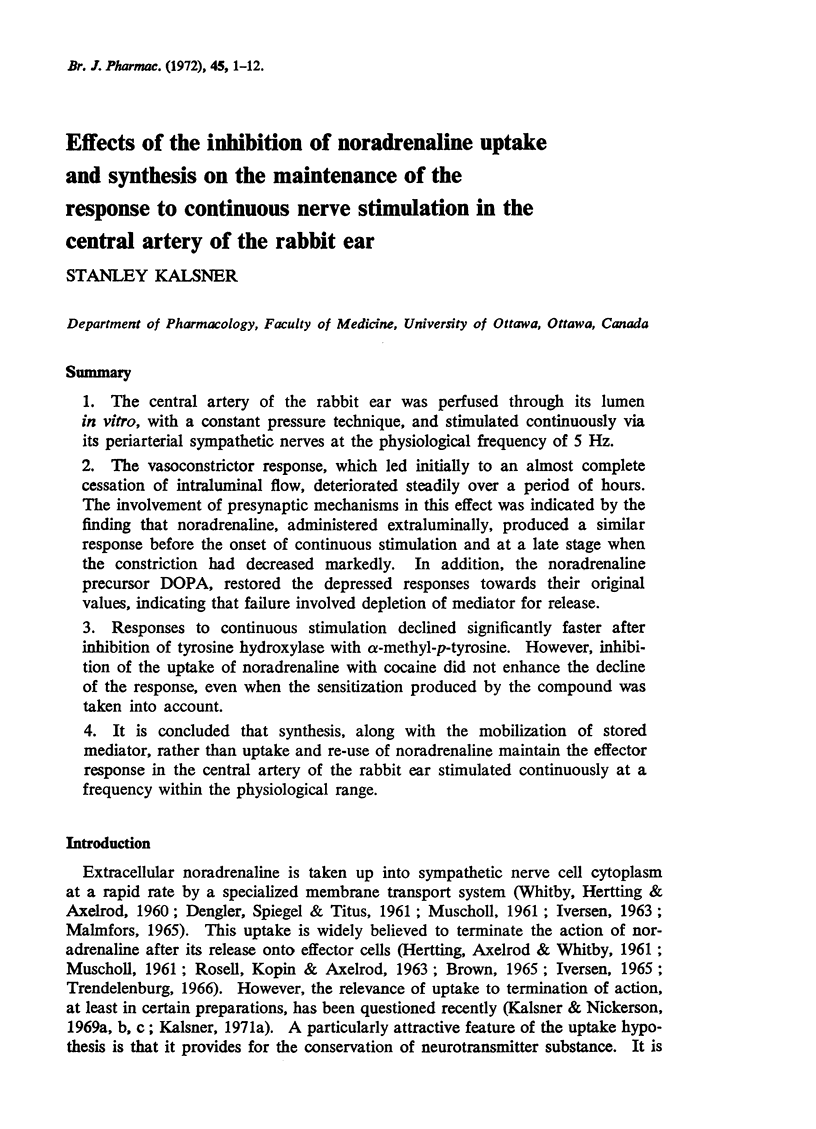
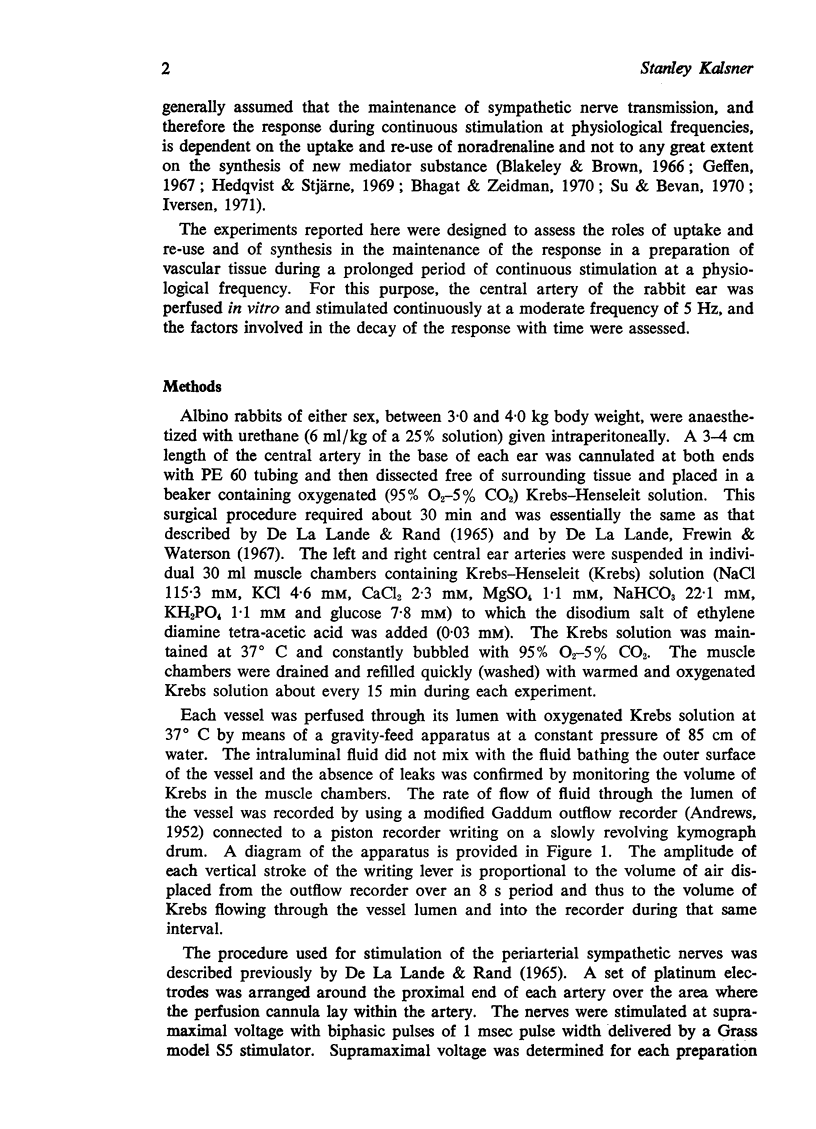
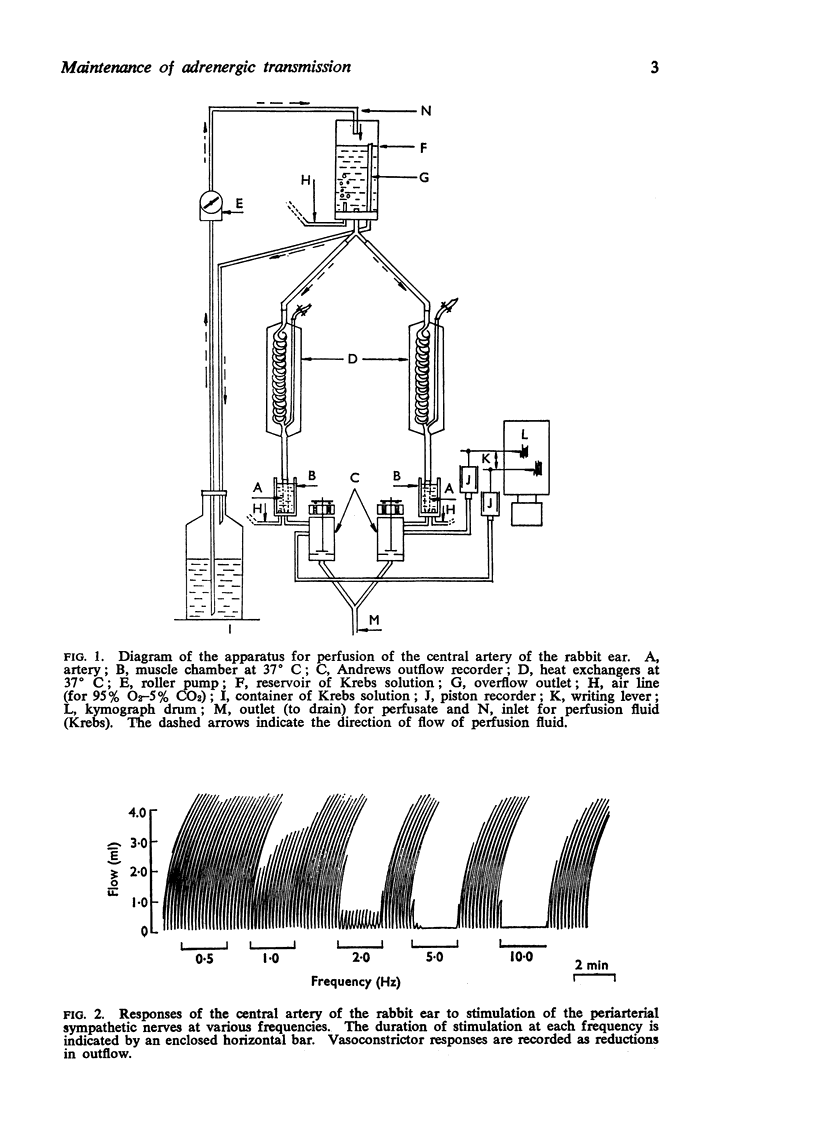
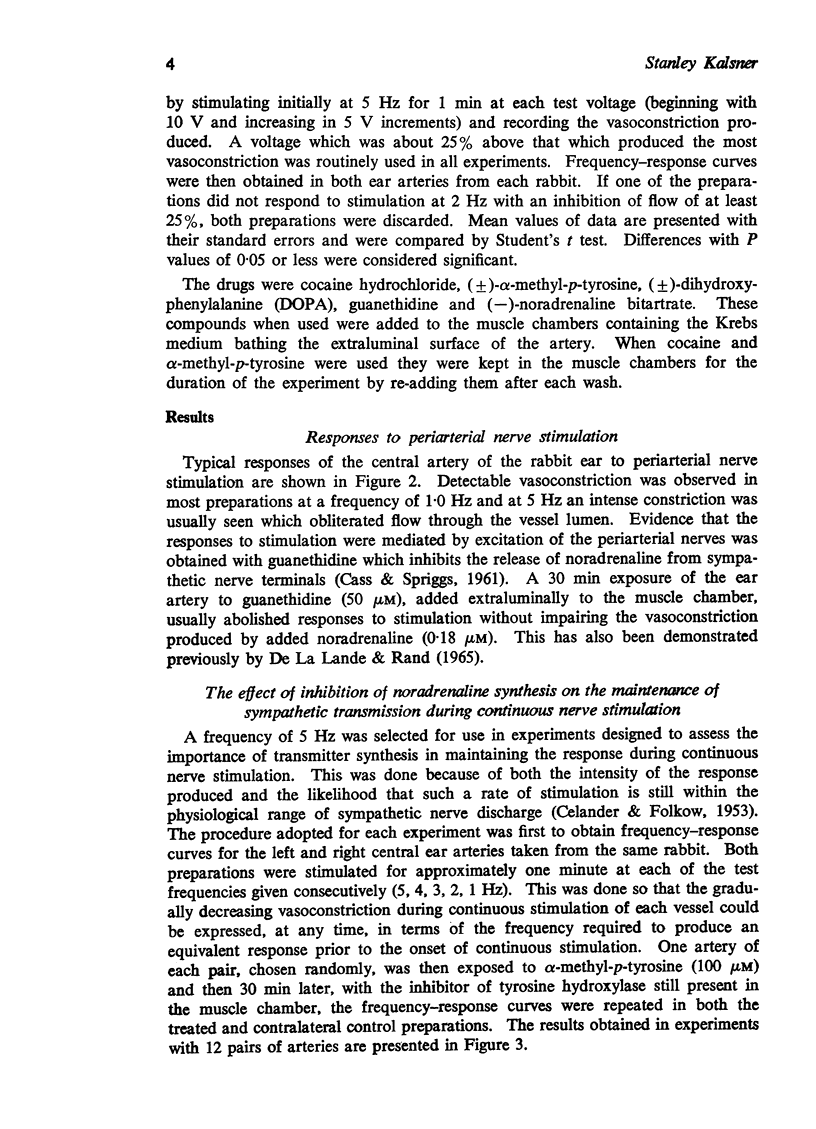
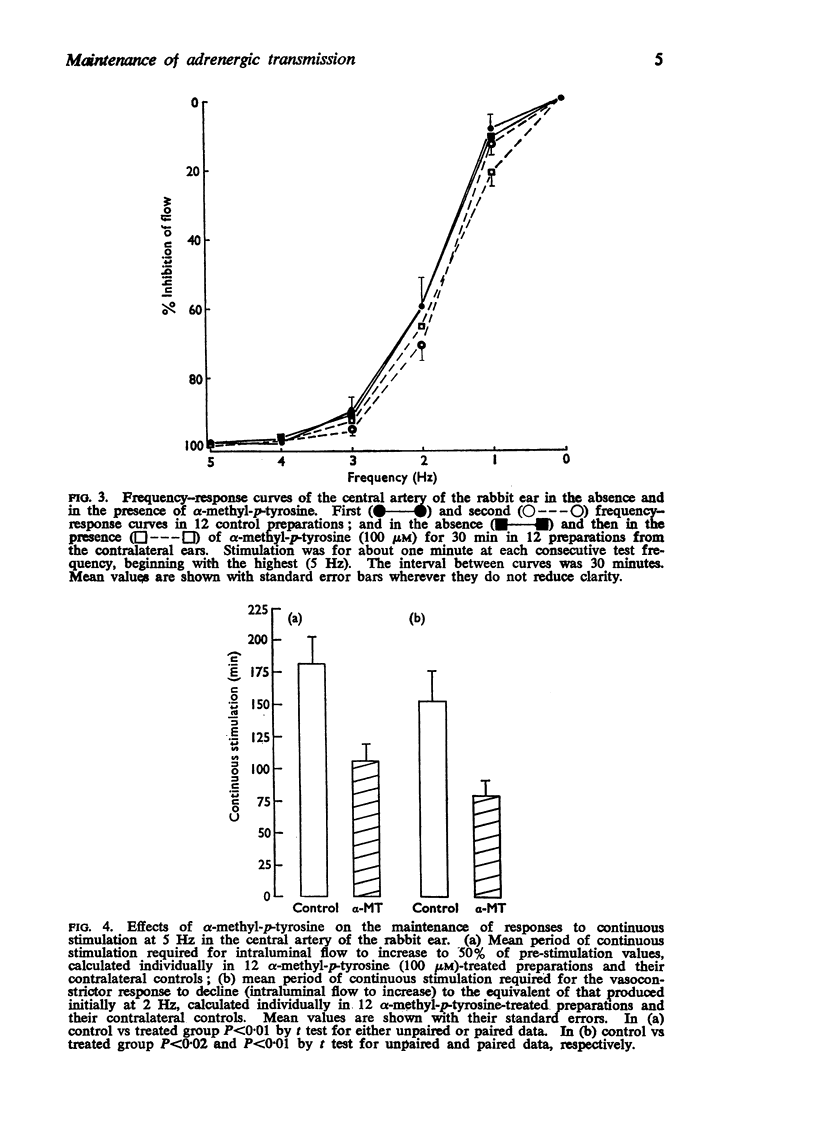
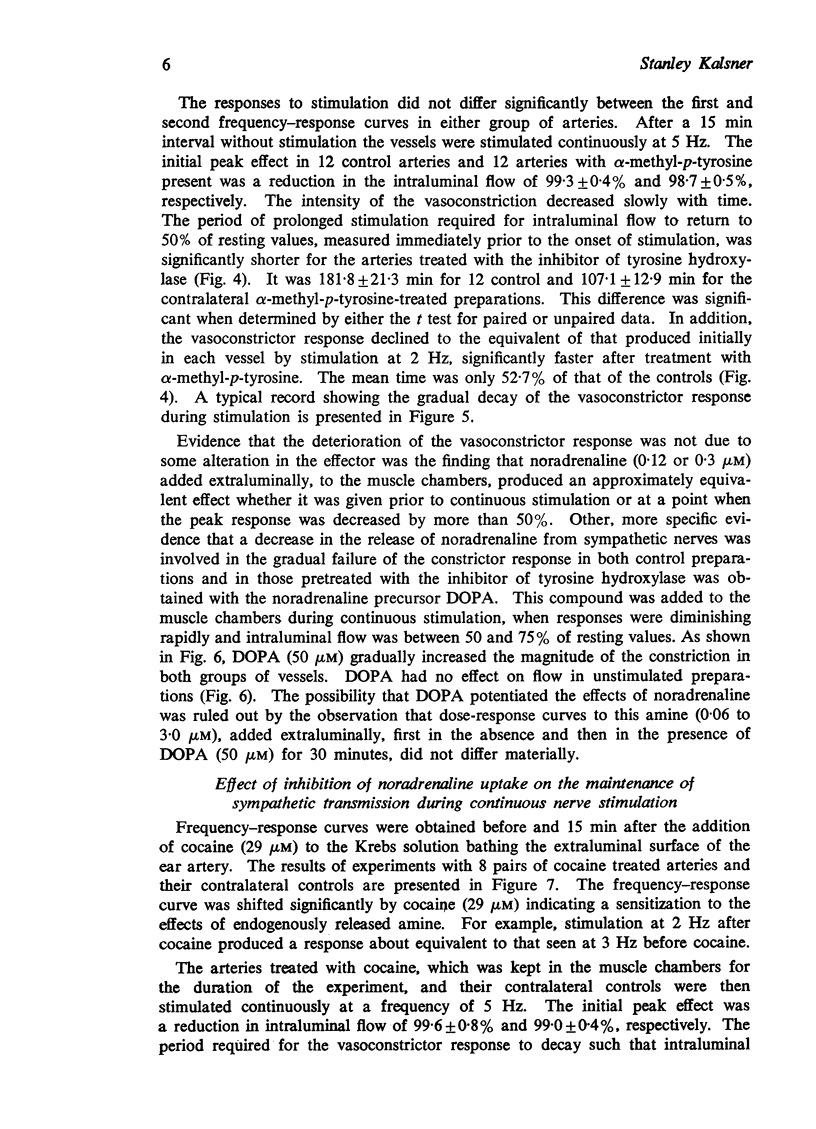
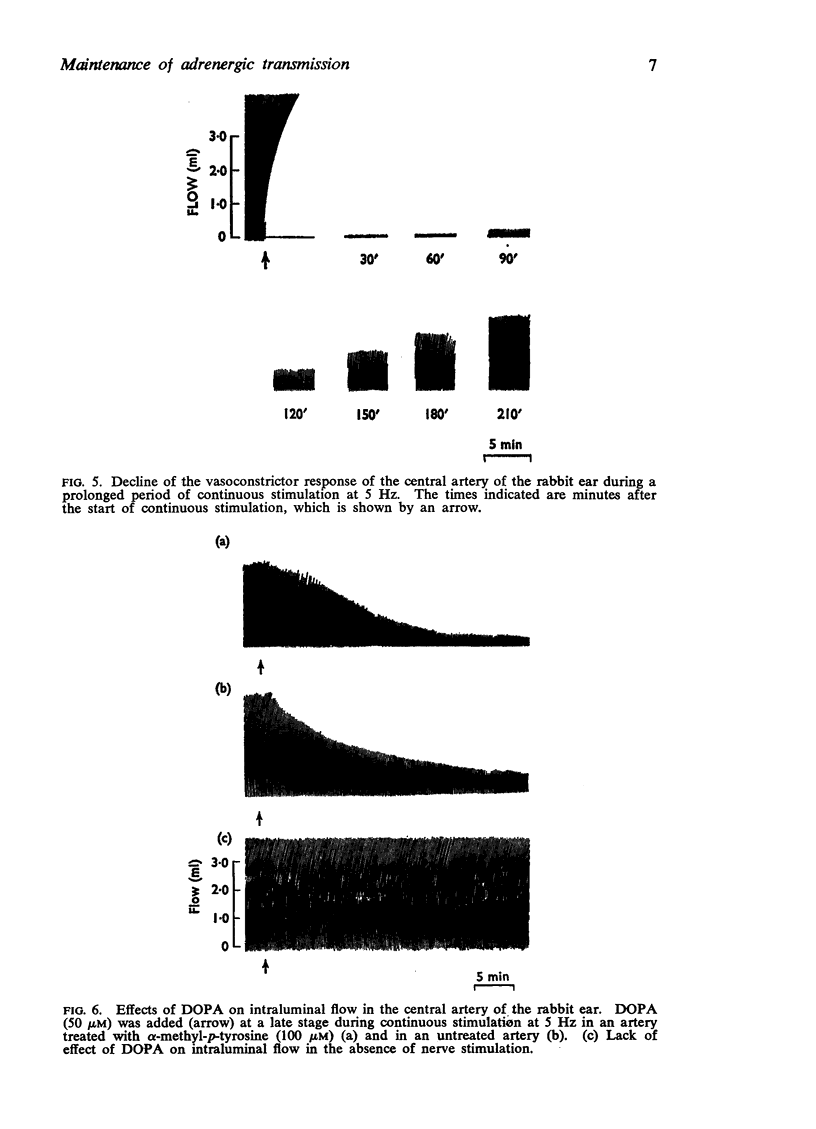
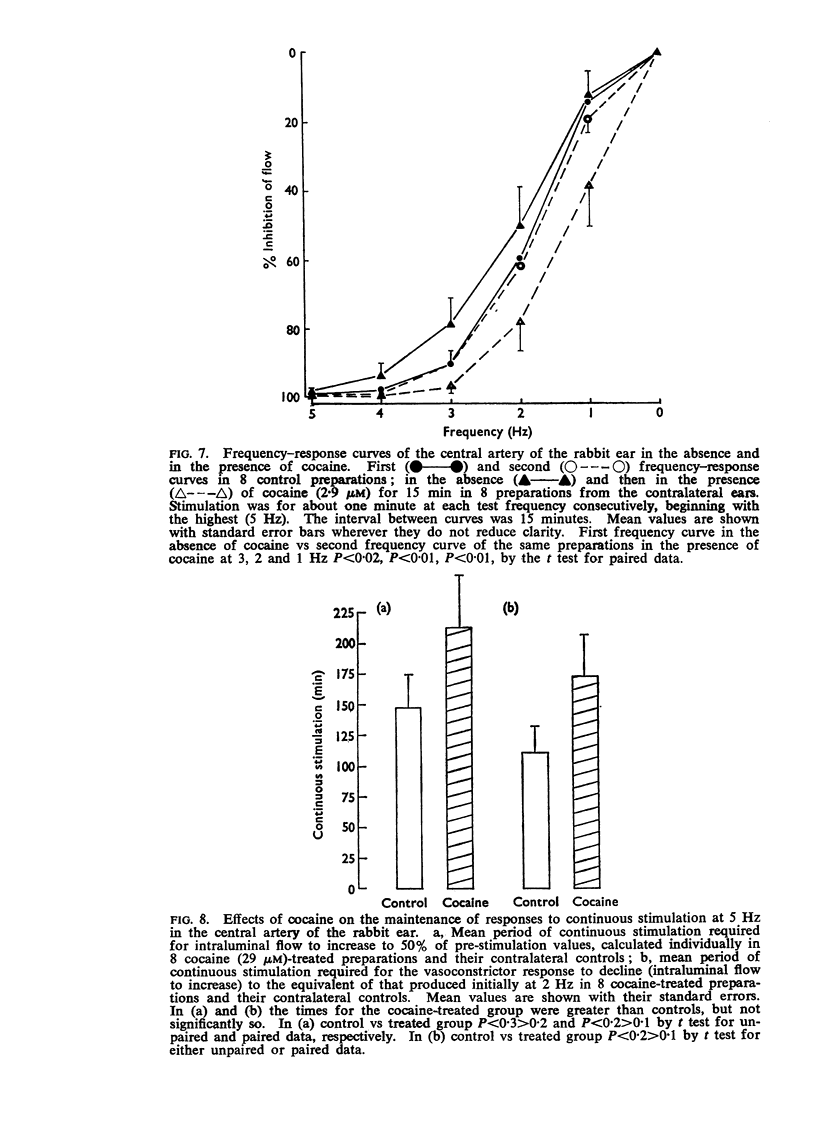
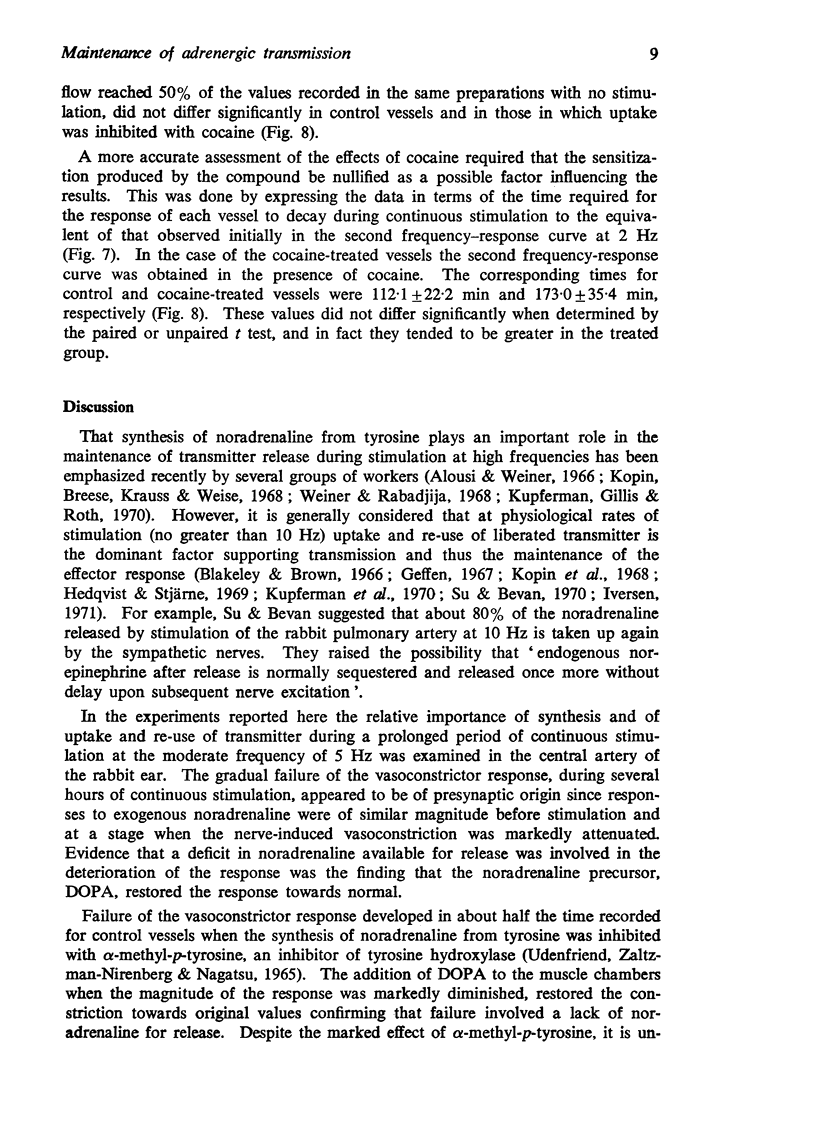
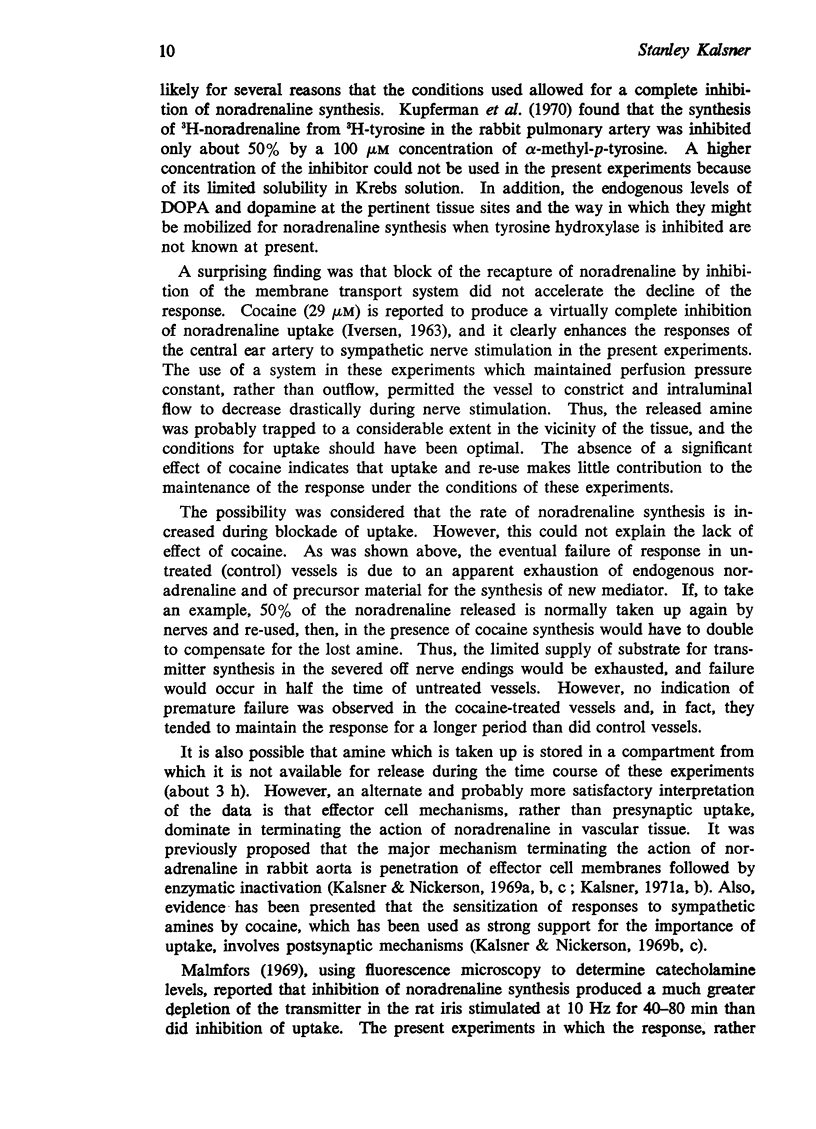
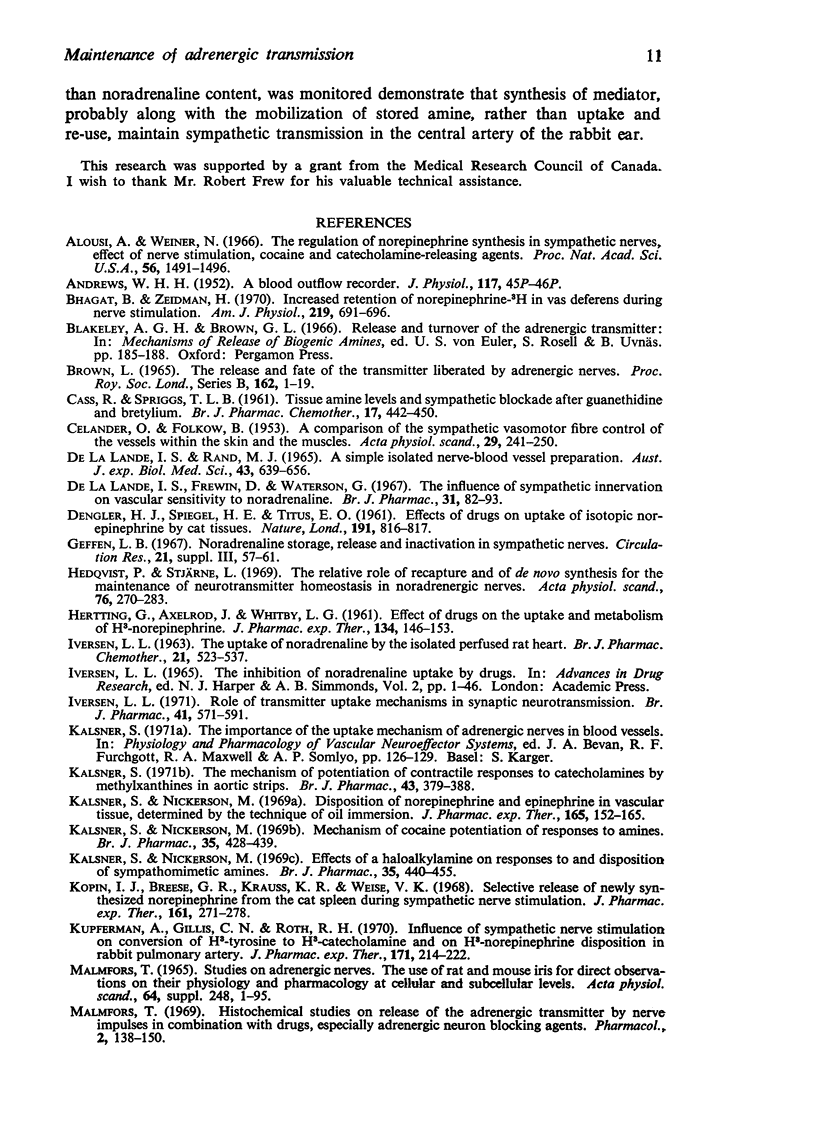
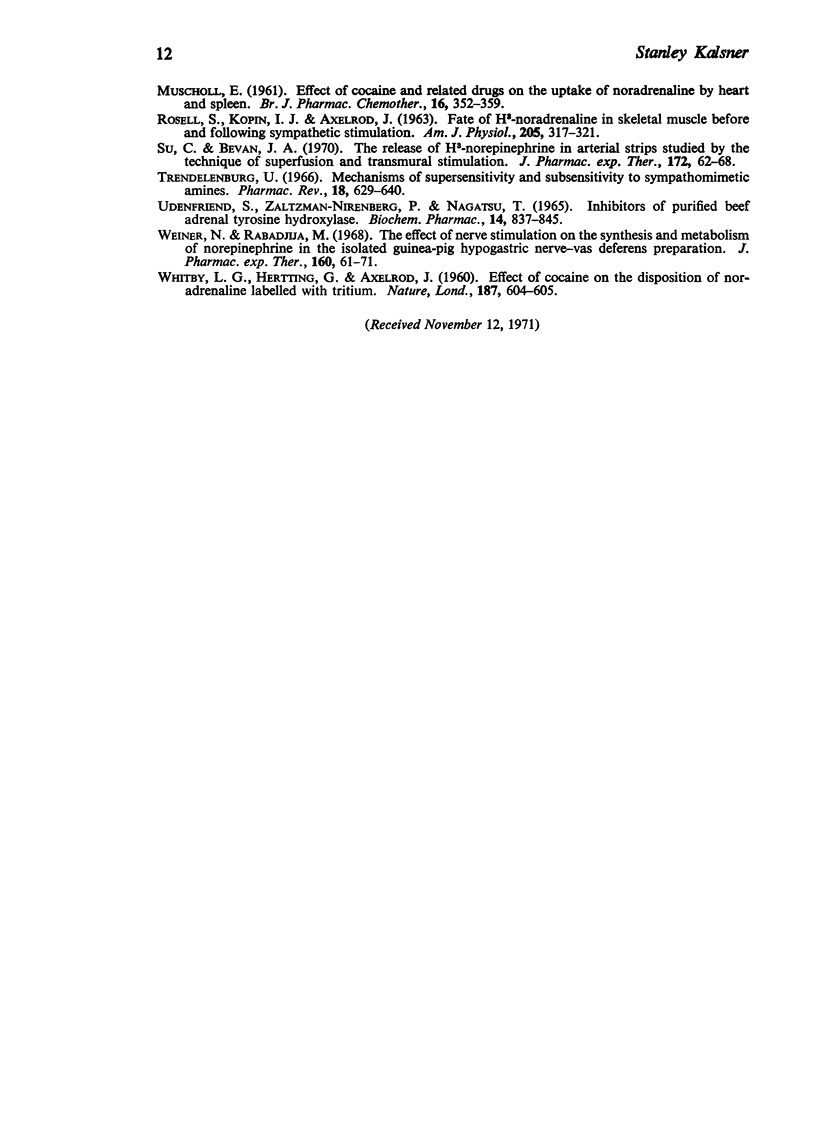
Selected References
These references are in PubMed. This may not be the complete list of references from this article.
- ANDREWS W. H. H. A blood outflow recorder. J Physiol. 1952 Aug;117(4):45P–46P. [PubMed] [Google Scholar]
- Alousi A., Weiner N. The regulation of norepinephrine synthesis in sympathetic nerves: effect of nerve stimulation, cocaine, and catecholamine-releasing agents. Proc Natl Acad Sci U S A. 1966 Nov;56(5):1491–1496. doi: 10.1073/pnas.56.5.1491. [DOI] [PMC free article] [PubMed] [Google Scholar]
- Bhagat B., Zeidman H. Increased retention of norepinephrine-3H in vas deferens during nerve stimulation. Am J Physiol. 1970 Sep;219(3):691–696. doi: 10.1152/ajplegacy.1970.219.3.691. [DOI] [PubMed] [Google Scholar]
- CASS R., SPRIGGS T. L. Tissue amine levels and sympathetic blockade after guanethidine and bretylium. Br J Pharmacol Chemother. 1961 Dec;17:442–450. doi: 10.1111/j.1476-5381.1961.tb01131.x. [DOI] [PMC free article] [PubMed] [Google Scholar]
- CELANDER O., FOLKOW B. A comparison of the sympathetic vasomotor fibre control of the vessels within the skin and the muscles. Acta Physiol Scand. 1953 Oct 6;29(2-3):241–250. doi: 10.1111/j.1748-1716.1953.tb01021.x. [DOI] [PubMed] [Google Scholar]
- DENGLER H. J., SPIEGEL H. E., TITUS E. O. Effects of drugs on uptake of isotopic norepinephrine by cat tissues. Nature. 1961 Aug 19;191:816–817. doi: 10.1038/191816a0. [DOI] [PubMed] [Google Scholar]
- De la Lande I. S., Frewin D., Waterson J. G. The influence of sympathetic innervation on vascular sensitivity to noradrenaline. Br J Pharmacol Chemother. 1967 Sep;31(1):82–93. doi: 10.1111/j.1476-5381.1967.tb01979.x. [DOI] [PMC free article] [PubMed] [Google Scholar]
- De la Lande I. S., Rand M. J. A simple isolated nerve-blood vessel preparation. Aust J Exp Biol Med Sci. 1965 Oct;43(5):639–656. doi: 10.1038/icb.1965.48. [DOI] [PubMed] [Google Scholar]
- HERTING G., AXELROD J., WHITBY L. G. Effect of drugs on the uptake and metabolism of H3-norepinephrine. J Pharmacol Exp Ther. 1961 Nov;134:146–153. [PubMed] [Google Scholar]
- Hedqvist P., Stjärne L. The relative role of recapture and of de novo synthesis for the maintenance of neurotransmitter homeostasis in noradrenergic nerves. Acta Physiol Scand. 1969 Jul;76(3):270–283. doi: 10.1111/j.1748-1716.1969.tb04470.x. [DOI] [PubMed] [Google Scholar]
- IVERSEN L. L. THE UPTAKE OF NORADRENALINE BY THE ISOLATED PERFUSED RAT HEART. Br J Pharmacol Chemother. 1963 Dec;21:523–537. doi: 10.1111/j.1476-5381.1963.tb02020.x. [DOI] [PMC free article] [PubMed] [Google Scholar]
- Iversen L. L. Role of transmitter uptake mechanisms in synaptic neurotransmission. Br J Pharmacol. 1971 Apr;41(4):571–591. doi: 10.1111/j.1476-5381.1971.tb07066.x. [DOI] [PMC free article] [PubMed] [Google Scholar]
- Iversen L. L. The inhibition of noradrenaline uptake by drugs. Adv Drug Res. 1965;2:1–46. [PubMed] [Google Scholar]
- Kalsner S. Mechanism of potentiation of contractor responses to catecholamines by methylxanthines in aortic strips. Br J Pharmacol. 1971 Oct;43(2):379–388. [PMC free article] [PubMed] [Google Scholar]
- Kalsner S., Nickerson M. Disposition of norepinephrine and epinephrine in vascular tissue, determined by the technique of oil immersion. J Pharmacol Exp Ther. 1969 Feb;165(2):152–165. [PubMed] [Google Scholar]
- Kalsner S., Nickerson M. Effects of a haloalkylamine on responses to and disposition of sympathomimetic amines. Br J Pharmacol. 1969 Mar;35(3):440–455. doi: 10.1111/j.1476-5381.1969.tb08285.x. [DOI] [PMC free article] [PubMed] [Google Scholar]
- Kalsner S., Nickerson M. Mechanism of cocaine potentiation of responses to amines. Br J Pharmacol. 1969 Mar;35(3):428–439. doi: 10.1111/j.1476-5381.1969.tb08284.x. [DOI] [PMC free article] [PubMed] [Google Scholar]
- Kopin I. J., Breese G. R., Krauss K. R., Weise V. K. Selective release of newly synthesized norepinephrine from the cat spleen during sympathetic nerve stimulation. J Pharmacol Exp Ther. 1968 Jun;161(2):271–278. [PubMed] [Google Scholar]
- Kupferman A., Gillis C. N. Roth RH: Influence of sympathetic nerve stimulation on conversion of H3-tyrosine to H3-catecholamine and on H3-norepinephrine disposition in rabbit pulmonary artery. J Pharmacol Exp Ther. 1970 Feb;171(2):214–222. [PubMed] [Google Scholar]
- MUSCHOLL E. Effect of cocaine and related drugs on the uptake of noradrenaline by heart and spleen. Br J Pharmacol Chemother. 1961 Jun;16:352–359. doi: 10.1111/j.1476-5381.1961.tb01095.x. [DOI] [PMC free article] [PubMed] [Google Scholar]
- Malmfors T. Histochemical studies on the release of the adrenergic transmitter by nerve impulses in combination with drugs, especially adrenergic neuron blocking agents. Pharmacology. 1969;2(3):138–150. doi: 10.1159/000136010. [DOI] [PubMed] [Google Scholar]
- ROSELL S., KOPIN I. J., AXELROD J. FATE OF H3-NORADRENALINE IN SKELETAL MUSCLE BEFORE AND FOLLOWING SYMPATHETIC STIMULATION. Am J Physiol. 1963 Aug;205:317–321. doi: 10.1152/ajplegacy.1963.205.2.317. [DOI] [PubMed] [Google Scholar]
- Su C., Bevan J. A. The release of H3-norepinephrine in arterial strips studied by the technique of superfusion and transmural stimulation. J Pharmacol Exp Ther. 1970 Mar;172(1):62–68. [PubMed] [Google Scholar]
- Trendelenburg U. Mechanisms of supersensitivity and subsensitivity to sympathomimetic amines. Pharmacol Rev. 1966 Mar;18(1):629–640. [PubMed] [Google Scholar]
- Udenfriend S., Zaltzman-Nirenberg P., Nagatsu T. Inhibitors of purified beef adrenal tyrosine hydroxylase. Biochem Pharmacol. 1965 May;14(5):837–845. doi: 10.1016/0006-2952(65)90103-6. [DOI] [PubMed] [Google Scholar]
- WHITBY L. G., HERTTING G., AXELROD J. Effect of cocaine on the disposition of noradrenaline labelled with tritium. Nature. 1960 Aug 13;187:604–605. doi: 10.1038/187604a0. [DOI] [PubMed] [Google Scholar]
- Weiner N., Rabadjija M. The effect of nerve stimulation on the synthesis and metabolism of norepinephrine in the isolated guinea-pig hypogastric nerve-vas deferens preparation. J Pharmacol Exp Ther. 1968 Mar;160(1):61–71. [PubMed] [Google Scholar]


